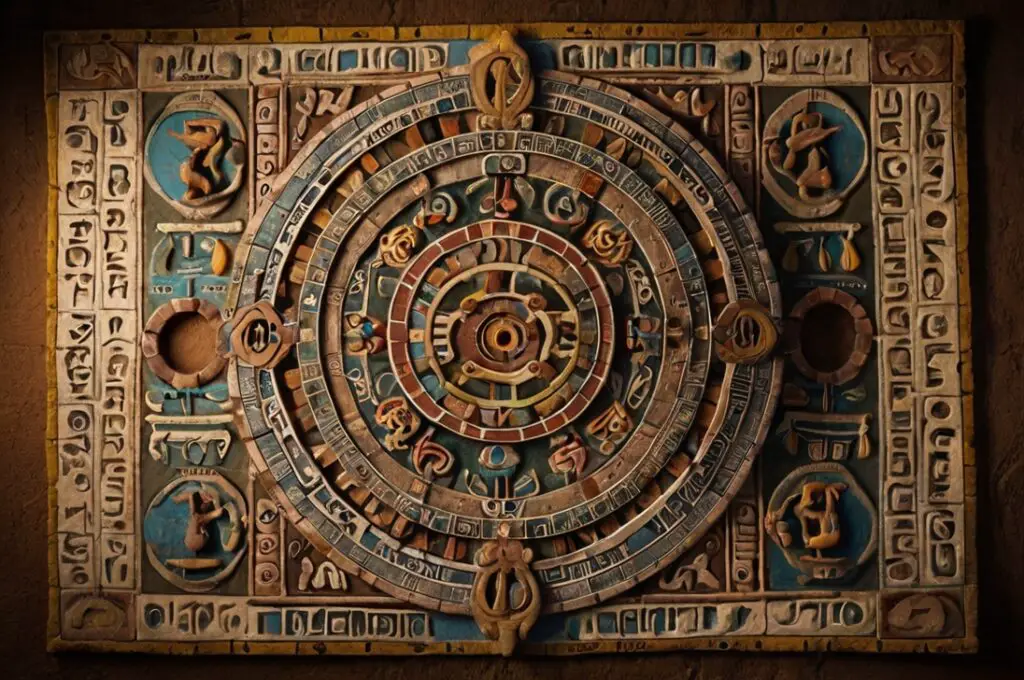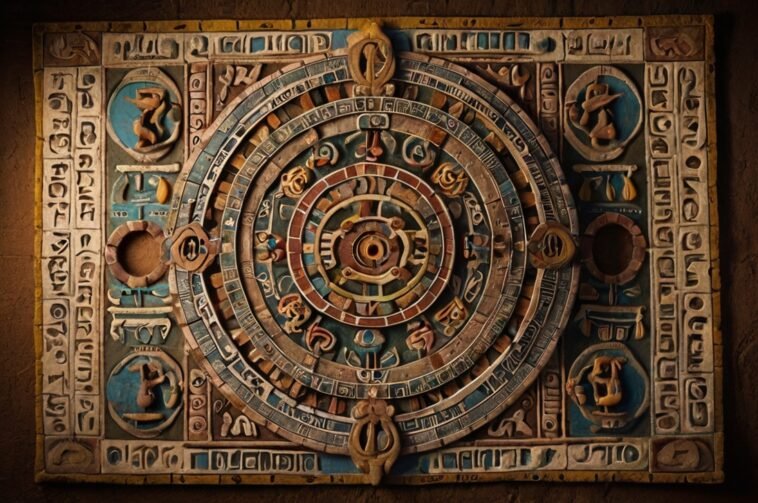
The ancient civilizations of Mesoamerica, including the Maya and Aztecs, were renowned for their advanced knowledge of astronomy, mathematics, and timekeeping.
One of their most remarkable achievements was the development of intricate calendar systems that helped them track time, predict celestial events, and organize religious ceremonies.
This blog will explore the unique characteristics of the Mesoamerican calendar system, focusing on the Maya and Aztec calendar systems, their influence on astronomy and religion, and the legacy they left behind.
Unique Characteristics of the Mesoamerican Calendar System
The Mesoamerican calendar system was very different from the modern Gregorian calendar.
It combined both solar and ritual cycles and wasn’t just about keeping track of days.
These calendars were a complex blend of astronomy, religious beliefs, divination, and agricultural cycles, all deeply connected to mythology.
One of the most fascinating aspects of this system was its cyclical view of time.
Mesoamericans saw time as repeating cycles, with each period influenced by gods and cosmic forces.
The calendars used a base-20 (vigesimal) system and could track both short-term cycles, like days and years, and long-term cosmic cycles that spanned thousands of years.
- Read also: Mayan Mythology: A Journey through the Ancient Civilization
- Read also: The Mayan Pantheon: Exploring the Deities of an Ancient Civilization

The Maya Calendar System
The Maya civilization is known for its complex and detailed calendar system, which was about much more than just keeping track of time.
Their calendars were deeply tied to their religious beliefs and worldview, playing an important role in their rituals and ceremonies.
The Tzolk’in (sacred calendar)
The Tzolk’in was the Maya’s sacred calendar, made up of 260 days divided into 20 periods of 13 days each.
This calendar was mainly used for religious and ceremonial purposes, helping mark important events and decide the timing of rituals.
Each day had a unique combination of a number and a named day, both of which had deep spiritual meaning.
According to The Journal of Mesoamerican Studies, the Tzolk’in was crucial for Maya priests, who used it in divination to interpret celestial events and understand the will of the gods.
Even today, some indigenous groups in modern-day Guatemala still use the Tzolk’in for ritual purposes, keeping this ancient tradition alive.
The Haab (solar calendar)
The Haab was the Maya’s solar calendar, consisting of 365 days divided into 18 months of 20 days each, plus a short 5-day period called the Wayeb.
These “nameless” days were seen as unlucky, with people believing that the boundary between the spiritual and physical worlds was weaker during this time.
This solar calendar was vital for agriculture, helping the Maya know when to plant and harvest crops.
Research published in the Mesoamerican Archaeology Journal shows that the Haab was incredibly accurate at tracking the solar year, on par with the modern Gregorian calendar, highlighting the Maya’s advanced knowledge of astronomy.
The calendar round
The Maya combined the Tzolk’in and Haab calendars to create what’s known as the Calendar Round, a cycle lasting 52 years.
After this period, both calendars would realign, which was a momentous event for the Maya.
At the end of each Calendar Round, special ceremonies were performed to ensure the world would continue for another cycle.
The Calendar Round was central to Maya ceremonial life and had great cultural and spiritual significance.

The Aztec Calendar System
The Aztecs, like the Maya, developed a sophisticated calendar system that was central to their culture and religion.
They used two main calendars: the Tonalamatl (a 260-day ritual calendar) and the Xiuhpohualli (a 365-day solar calendar).
The Tonalamatl (divinatory calendar)
The Tonalamatl was similar to the Maya’s Tzolk’in, serving as a 260-day ritual calendar.
Each day in the Tonalamatl was linked to a specific god or supernatural force, and it was used for divination and planning religious ceremonies.
Aztec priests consulted this calendar to find the most favorable dates for important events such as births, marriages, and even military campaigns (Journal of Aztec Religion and Mythology).
The Xiuhpohualli (solar calendar)
The Xiuhpohualli was the Aztec’s solar calendar, consisting of 365 days, divided into 18 months of 20 days each, with an extra five “unlucky” days at the end—similar to the Maya’s Haab.
This calendar was essential for both agriculture and religious festivals.
Each month was tied to a specific festival honoring a particular god, aligning the Aztec religious year closely with their agricultural cycle.
Studies in The Journal of Mesoamerican Astronomy show that the Xiuhpohualli was highly accurate at predicting seasonal changes, which allowed the Aztecs to effectively plan their farming activities around it.
Influence of the Mesoamerican Calendar System

The Mesoamerican calendar system played a central role in the lives of ancient civilizations like the Maya and Aztecs, shaping their astronomy, mythology, religion, and even aspects of modern-day culture.
Impact on astronomy and astrology
The Mesoamerican calendars were more than just ways to keep track of time—they were essential for observing the stars and planets.
By carefully tracking celestial bodies, the Maya and Aztecs could predict solar and lunar eclipses, solstices, and equinoxes.
Their understanding of astronomy was incredibly advanced for their time, as noted in Mesoamerican Astronomy Journal.
The alignment of their temples and pyramids with significant celestial events further shows their deep knowledge of the cosmos.
Influence on mythology and religion
Mythology and religion were deeply intertwined with the Mesoamerican calendars.
The people believed that gods controlled the cycles of time, and each day or year was influenced by specific deities.
Significant periods, like the end of a Calendar Round or the “unlucky” Wayeb days, were spiritually important and marked by elaborate religious ceremonies.
Legacy in modern-day culture
The impact of the Mesoamerican calendar system can still be seen today.
Some indigenous groups in Mexico and Central America continue to use the Tzolk’in calendar for religious and ceremonial purposes.
The famous Aztec calendar stone, known as the Sun Stone, is a lasting symbol of Mexico’s rich cultural heritage.
In recent times, the Maya calendar gained global attention during the 2012 phenomenon.
Many believed the Maya Long Count calendar predicted the end of the world in 2012.
However, scholars clarified that it simply marked the end of one cycle and the beginning of another, not an apocalypse (Maya Studies Quarterly).
- Read also: The Mesopotamian Pantheon: A Journey into Ancient Deities
- Read also: The Rise and Fall: A Journey Through Babylonian Empire Timeline
Final Thoughts
The Mesoamerican calendar systems were some of the most sophisticated timekeeping methods ever developed.
From the Maya’s precise astronomical calculations to the Aztecs’ intricate religious festivals, these calendars played a central role in shaping the civilizations that used them.
Today, their legacy lives on, influencing modern-day culture, religion, and even global fascination with ancient timekeeping systems.



